Blockchain-Based Cooperative Medical Records Management System
Abstract
1. Introduction
2. Related Work
2.1. Blockchain Technology
2.2. Blockchain in Healthcare
3. System Requirements
- -
- System Requirements for Patients.
- -
- System Requirement for Doctors.
- -
- System Requirement for Insurance Companies.
- -
- System Requirements for Healthcare Providers.
- -
- System Requirement for Ministry of Health.
- -
- Performance (Latency): The system shall maintain an average patient record retrieval latency below 100 ms under up to 100 concurrent requests.
- -
- Performance (Throughput): The system shall sustain at least 200 requests per second with 300 concurrent users.
- -
- Security: The system shall ensure confidentiality of medical records using asymmetric encryption, with access controlled through one-time tokens that expire after use.
- -
- Availability: The system shall provide continuous access to medical records through blockchain replication, ensuring resilience against individual service failures.
4. System Design
4.1. System Workflow
- ○
- Step 1: The patient generates access policies for the blockchain, and this enables the system to evaluate access requests without the need to approach the patient directly. Access requests are automatically granted or rejected.
- ○
- Step 2: When the patient consults a healthcare provider, the healthcare provider creates the patient’s medical record and stores it in the database.
- ○
- Step 3: The healthcare provider stores the reference to this record on the blockchain network in order to ensure the integrity of patient data and enable other parties in the system to access the medical record.
- ○
- Step 4: To complete the treatment process, the doctor requests permission to access the patient’s record using the patient’s address on the blockchain. The request is processed through the access policy in the smart contract, which considers the request and checks the patient’s access policies.
- ○
- Step 5: To grant access to the doctor, the request is redirected to the encryption server. This generates a secure access token for the doctor. This process is completed using a smart contract named Registration.
- ○
- Step 6: The doctor, using the secure access token, can review the patient’s medical record and add details about the patient’s visit.
- ○
- Step 1: The patient generates access policies for the blockchain.
- ○
- Step 2: The healthcare provider files the patient’s insurance claim, which is then stored in the smart contract on the blockchain network named Claim. Subsequently, the insurance company is notified.
- ○
- Step 3: The company requests permission to access the patient’s record by employing the methods delineated in Step 4 in patient–doctor–health provider workflow section.
- ○
- Step 4: To grant access to the insurance company, the request is redirected to the encryption server. This generates a secure access token for the insurance company. This process is completed using a smart contract named Registration.
- ○
- Step 5: The healthcare provider uses the secure access token to access the patient’s medical record.
- ○
- Step 6: The healthcare provider evaluates the claim made by its medical staff based on the data in the patient’s medical record and then either accepts or rejects it.
4.2. Threats Modeling
5. System Implementation
- Create Access Policies Function
- View Medical Record Contents Function
- Create Medical Insurance Claim Function
- Update Patient Medical Record Function
- Processing Medical Insurance Claim Function
6. Evaluation
6.1. Qualitative Evaluation
- Patient logs into the health provider system with username and password.
- Patient makes a “visit notice” request.
- System retrieves date of visit, clinic type, and patient number and name.
- Patient logs into the “tracking and auditing medical record system” with wallet address.
- Patient makes “view visit log” request to blockchain.
- System retrieves visits added in patient’s medical record.
- Patient views his/her visit log to see what information has been added to the medical record and by whom.
| Classic Health Record System | Blockchain Health Record System |
|---|---|
| Patients can see basic information, such as the name of the clinic and date of the visit, and can access X-rays and test results. Patients cannot see other information, such as the doctor’s notes. Patients can access information associated with this hospital only. | Patients can access their medical record, which includes the entire history of visits to any healthcare provider in any city in Saudi Arabia. The visit history contains information about doctors, healthcare providers, diagnoses and health conditions, and treatment plans, and any attachments to the records can be viewed. This enables patients to track information in their medical record. |
| Information added to a patient’s medical record by a doctor can be modified or deleted. | Information added to a patient’s medical record, especially visit content added by any doctor, cannot be modified or deleted. |
- Doctor logs onto the health provider system with username and password.
- Doctor clicks on “today’s patient list” in the health provider system.
- Doctor selects intended patient from the patient list.
- System retrieves medical records of patient associated with this hospital only.
- Doctor logs onto the “tracking and auditing medical record system” with wallet address.
- Doctor clicks on “patient history” in the system.
- Doctor chooses intended patient from the list.
- Doctor makes an “access patient history” request to the system.
- Based on the access policies of the patient, the request is accepted and the access token is released or the request is denied.
- System retrieves encoded patient medical record content.
- Confidential medical record contents are decrypted via the doctor’s private key.
- Doctor views details of patient’s history from all healthcare providers.
| Classic Health Record System | Blockchain Health Record System |
|---|---|
| Doctor can access patient’s medical record at any time without any access control or awareness on the part of the patient. | Doctor needs an access token to access patient’s medical records. The token is accepted or rejected based on access policies determined by the patient. |
| Doctor can only view data on previous visits by the patient to a doctor in the same healthcare provider’s system. | Doctor can view details of the patient’s history regardless of the type of patient or the healthcare provider who treated the patient. Doctor can see all of the details of the patient’s medical conditions and all previous treatments and medications from all healthcare providers that the patient has consulted. This information is encrypted asymmetrically and decrypted through the doctor’s private key. |
- Insurance company logs into the claims system.
- System retrieves the patient’s medical claims.
- Insurance company selects the claim and adds a response to the claim, which is either an acceptance or rejection of the claim.
- Insurance company logs onto the “Tracking and Auditing Medical Record System” with wallet address.
- Insurance company clicks on “New Claims” in the system.
- Insurance company chooses a medical claim from the list.
- Insurance company makes an “Access Patient Medical Record” request to the system.
- Based on the access policies of the patient, the system accepts the request and releases the access token or denies the request.
- System retrieves encoded patient medical record content related to the visit that led to the medical claim.
- Confidential patient medical record contents are decrypted via the insurance company’s private key.
- Insurance company selects either the “Accept” or “Reject” option for the medical claim.
| Classic Health Record System | Blockchain Health Record System |
|---|---|
| The content of a claim, including the medical data associated with the claim, can be accessed at any time by the insurance company without the patient’s knowledge. | The insurance company needs an access token to access a patient’s medical record when evaluating medical claims. The release of this access token is based on access policies determined by the patient. |
| To process the medical claim, the insurance company may require special information related to the claim. It may need to contact the healthcare provider to obtain the information. This process may require time and effort. | When access is granted, the insurance company can easily access details of the visit and all of the attachments related to it. |
6.2. Quantitative Evaluation
7. Conclusions
Author Contributions
Funding
Data Availability Statement
Acknowledgments
Conflicts of Interest
Appendix A. Code Snippets of the Smart Contracts


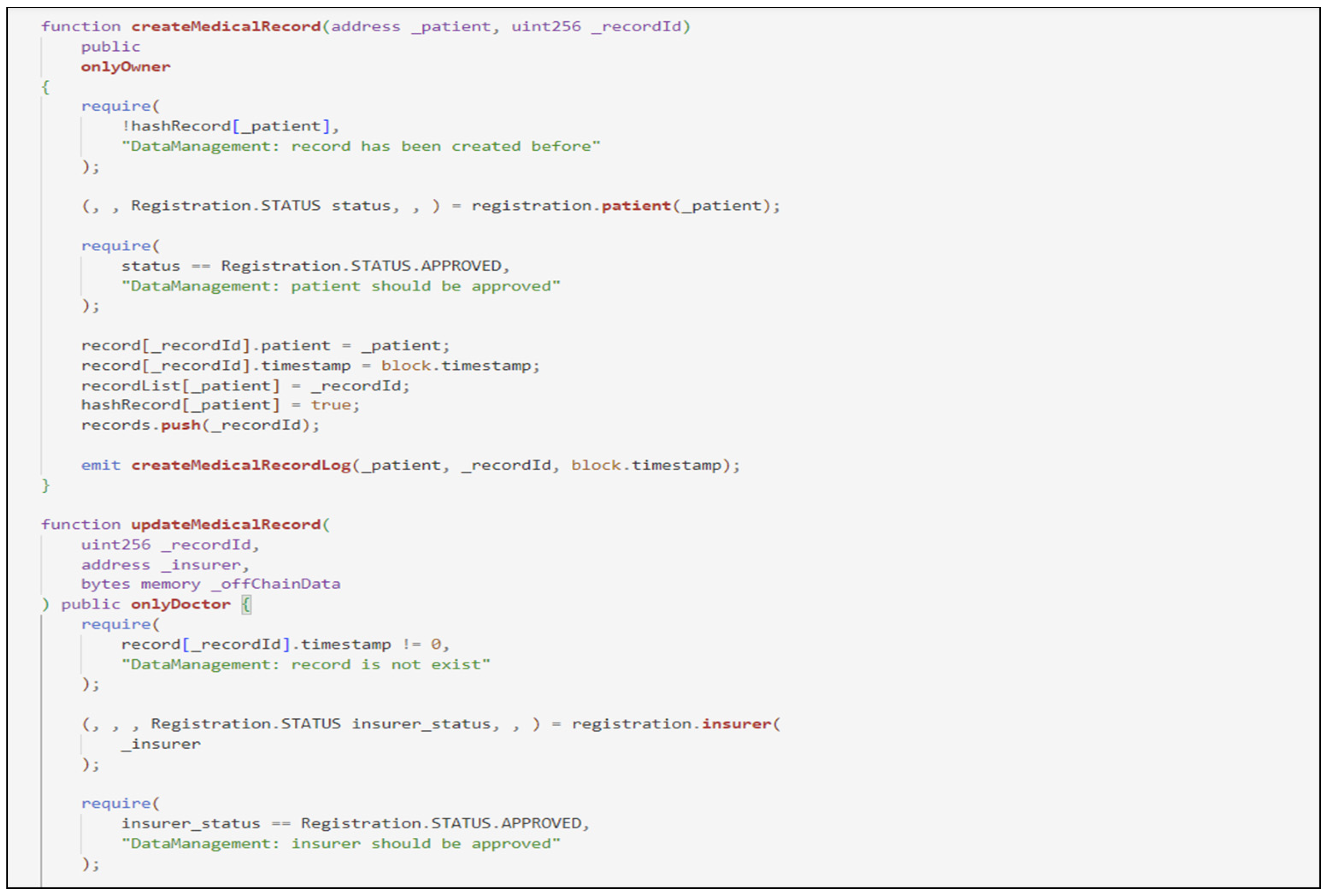

References
- Mohanta, B.K.; Panda, S.S.; Jena, D. An overview of smart contract and use cases in blockchain technology. In Proceedings of the 2018 9th International Conference on Computing, Communication and Networking Technologies (ICCCNT), Bengaluru, India, 10–12 July 2018; pp. 1–4. [Google Scholar] [CrossRef]
- Golosova, J.; Romanovs, A. Overview of the blockchain technology cases. In Proceedings of the 2018 59th International Scientific Conference on Information Technology and Management Science of Riga Technical University (ITMS), Riga, Latvia, 10 October 2018; pp. 1–6. [Google Scholar]
- Ruben, R.J. Special communication. Int. J. Pediatr. Otorhinolaryngol. 2000, 54, 77. [Google Scholar] [CrossRef] [PubMed]
- John, S.; Ravichandran, N.; Khan, M.F. Electronic medical record for deliverance of effective healthcare delivery: Ethical issues and challenges of digitalization in clinical information and electronic medical records (EMR) management. IOSR J. Bus. Manag. 2018, 20, 106–112. [Google Scholar]
- Liang, X.; Zhao, J.; Shetty, S.; Liu, J.; Li, D. Integrating blockchain for data sharing and collaboration in mobile healthcare applications. In Proceedings of the 2017 IEEE Annual International Symposium on Personal, Indoor and Mobile Radio Communications (PIMRC), Montreal, QC, Canada, 8–13 October 2017; pp. 1–5. [Google Scholar] [CrossRef]
- Alshahrani, A.; Stewart, D.; MacLure, K. A systematic review of the adoption and acceptance of eHealth in Saudi Arabia: Views of multiple stakeholders. Int. J. Med. Inform. 2019, 128, 7–17. [Google Scholar] [CrossRef]
- Jabali, A.K.; Jarrar, M. Electronic health records functionalities in Saudi Arabia: Obstacles and major challenges. Glob. J. Health Sci. 2018, 10, 50. [Google Scholar] [CrossRef]
- Prokofieva, M.; Miah, S.J. Blockchain in healthcare. Australas. J. Inf. Syst. 2019, 23, 1–22. [Google Scholar] [CrossRef]
- Dubey, R.; Gunasekaran, A.; Bryde, D.J.; Dwivedi, Y.K.; Papadopoulos, T. Blockchain technology for enhancing swift-trust, collaboration and resilience within a humanitarian supply chain setting. Int. J. Prod. Res. 2020, 58, 3381–3398. [Google Scholar] [CrossRef]
- Acharya, S.; Coats, B.; Saluja, A.; Fuller, D. Secure electronic health record exchange: Achieving the meaningful use objectives. In Proceedings of the 2013 46th Hawaii International Conference on System Sciences, Wailea, Maui, 7–10 January 2013; pp. 2555–2564. [Google Scholar] [CrossRef]
- Zubaydi, H.D.; Chong, Y.W.; Ko, K.; Hanshi, S.M.; Karuppayah, S. A review on the role of blockchain technology in the healthcare domain. Electronics 2019, 8, 679. [Google Scholar] [CrossRef]
- Haleem, A.; Javaid, M.; Singh, R.P.; Suman, R.; Rab, S. Blockchain technology applications in healthcare: An overview. Int. J. Intell. Netw. 2021, 2, 130–139. [Google Scholar] [CrossRef]
- Golosova, J.; Romanovs, A. The advantages and disadvantages of the blockchain technology. In Proceedings of the 2018 IEEE 6th Workshop on Advances in Information, Electronic and Electrical Engineering (AIEEE), Vilnius, Lithuania, 8–10 November 2018; pp. 1–6. [Google Scholar] [CrossRef]
- Lapointe, C.; Fishbane, L. The blockchain ethical design framework. Innov. Technol. Gov. Glob. 2019, 12, 50–71. [Google Scholar] [CrossRef]
- Halaburda, H. Blockchain revolution without the blockchain. Commun. ACM 2018, 61, 27–29. [Google Scholar] [CrossRef]
- Tasatanattakool, P.; Techapanupreeda, C. Blockchain: Challenges and applications. In Proceedings of the 2018 International Conference on Information Networking (ICOIN), Chiang Mai, Thailand, 10–12 January 2018; pp. 473–475. [Google Scholar] [CrossRef]
- Agbo, C.C.; Mahmoud, Q.H.; Eklund, J.M. Blockchain technology in healthcare: A systematic review. Healthcare 2019, 7, 56. [Google Scholar] [CrossRef] [PubMed]
- Puthal, D.; Malik, N.; Mohanty, S.P.; Kougianos, E.; Das, G. Everything you wanted to know about the blockchain: Its promise, components, processes, and problems. IEEE Consum. Electron. Mag. 2018, 7, 6–14. [Google Scholar] [CrossRef]
- El Mahalli, A. Electronic health records: Use and barriers among physicians in eastern province of Saudi Arabia. Saudi J. Health Sci. 2015, 4, 32–41. [Google Scholar] [CrossRef]
- Nguyen, T.D.; Vu, H.D.; Webster, J.G.; Nimunkar, A.J. A web-based electronic medical records and hospital information system for developing countries. J. Health Inform. Dev. Ctries. 2011, 5, 155–170. [Google Scholar]
- Zheng, Z.; Xie, S.; Dai, H.N.; Chen, X.; Wang, H. Blockchain challenges and opportunities: A survey. Int. J. Web Grid Serv. 2018, 14, 352–375. [Google Scholar] [CrossRef]
- Li, X.; Jiang, P.; Chen, T.; Luo, X.; Wen, Q. A survey on the security of blockchain systems. Futur. Gener. Comput. Syst. 2020, 107, 841–853. [Google Scholar] [CrossRef]
- Yahaya, S.; Jilantikiri, L.; Hassan, K.; Akande, K.; Yahaya, A. Development of an automated healthcare record management system. Adeleke Univ. J. Eng. Technol. 2019, 4, 79–90. [Google Scholar]
- Rakic, D. Blockchain technology in healthcare. ICT4AWE 2018. In Proceedings of the 4th International Conference on Information and Communications Technologies for Ageing Well and e-Health (ICT4AWE 2018), Madeira, Portugal, 22–23 March 2018; pp. 13–20. [Google Scholar] [CrossRef]
- Liang, X.; Yan, Z.; Zhang, P. Security, privacy, and anonymity in computation, communication, and storage. In Proceedings of the 10th International Conference on Security, Privacy and Anonymity in Computation, Communication and Storage (SpaCCS 2016), Zhangjiajie, China, 16–18 November 2016; pp. 155–167. [Google Scholar] [CrossRef]
- Benchoufi, M.; Porcher, R.; Ravaud, P. Blockchain protocols in clinical trials: Transparency and traceability of consent. F1000Research 2017, 6, 66. [Google Scholar] [CrossRef]
- Maslove, D.M.; Klein, J.; Brohman, K.; Martin, P. Using blockchain technology to manage clinical trials data: A proof-of-concept study. JMIR Med. Inform. 2018, 6, e11949. [Google Scholar] [CrossRef]
- Tseng, J.H.; Liao, Y.C.; Chong, B.; Liao, S.W. Governance on the drug supply chain via gcoin blockchain. Int. J. Environ. Res. Public Health 2018, 15, 1055. [Google Scholar] [CrossRef]
- Katuwal, G.J.; Pandey, S.; Hennessey, M.; Lamichhane, B. Applications of blockchain in healthcare: Current landscape & challenges. arXiv 2018, arXiv:1812.02776. [Google Scholar] [CrossRef]
- Cyran, M.A. Blockchain as a foundation for sharing healthcare data. Blockchain Healthc. Today 2018. [Google Scholar] [CrossRef]
- Alam, S.; Reegu, F.A.; Daud, S.M.; Shuaib, M. Blockchain-based electronic health record system for efficient COVID-19 pandemic management. Preprints 2021, 1–5. [Google Scholar] [CrossRef]
- Patel, V. A framework for secure and decentralized sharing of medical imaging data via blockchain consensus. Health Inform. J. 2019, 25, 1398–1411. [Google Scholar] [CrossRef] [PubMed]
- Dagher, G.G.; Mohler, J.; Milojkovic, M.; Marella, P.B. Ancile: Privacy-preserving framework for access control and interoperability of electronic health records using blockchain technology. Sustain. Cities Soc. 2018, 39, 283–297. [Google Scholar] [CrossRef]
- Xia, Q.; Sifah, E.B.; Smahi, A.; Amofa, S.; Zhang, X. BBDS: Blockchain-based data sharing for electronic medical records in cloud environments. Information 2017, 8, 44. [Google Scholar] [CrossRef]
- Tahir, N.U.A.; Rashid, U.; Hadi, H.J.; Ahmad, N.; Cao, Y.; Alshara, M.A.; Javed, Y. Blockchain-based healthcare records management framework: Enhancing security, privacy, and interoperability. Technologies 2024, 12, 168. [Google Scholar] [CrossRef]
- Kumari, D.; Parmar, A.S.; Goyal, H.S.; Mishra, K.; Panda, S. Healthrec-chain: Patient-centric blockchain enabled ipfs for privacy preserving scalable health data. Comput. Netw. 2024, 241, 110223. [Google Scholar] [CrossRef]
- Alruwaill, M.N.; Mohanty, S.P.; Kougianos, E. hChain 4.0: A Secure and Scalable Permissioned Blockchain for EHR Management in Smart Healthcare. arXiv 2025, arXiv:2505.13861. [Google Scholar] [CrossRef]
- Zain, B.; Shawkat Ali, A.B.M.; Sakzad, A. Blockchain-Powered Fraud Prevention in Health Insurance Industry. In Proceedings of the 6th ACM International Symposium on Blockchain and Secure Critical Infrastructure, Singapore, 1–5 July 2024. [Google Scholar]
- Hsiao, C.J.; Marsteller, J.A.; Simon, A.E. Electronic medical record features and seven quality of care measures in physician offices. Am. J. Med. Qual. 2014, 29, 44–52. [Google Scholar] [CrossRef]
- Brasil, L.M.; Abreu, C.G.; Vieira, A.G.; Machado, M.A.; Almeida, V.S.; Rodrigues, R.M. System of web-based electronic medical record. Rev. Eletrônica Sist. Informação 2007, 6. [Google Scholar] [CrossRef]
- Sarfraz, M.; Al-Hussainan, A.F.; Mohammad, F.; Al-Azmi, H. An electronic medical record system. Int. J. Extrem. Autom. Connect. Healthc. 2019, 2, 68–102. [Google Scholar] [CrossRef]
- Stiemerling, O.; Cremers, A.B. The use of cooperation scenarios in the design and evaluation of a CSCW system. IEEE Trans. Softw. Eng. 1998, 24, 1171–1181. [Google Scholar] [CrossRef]
- Haynes, S.R.; Purao, S.; Skattebo, A.L. Scenario-based methods for evaluating collaborative systems. Comput. Support. Coop. Work 2009, 18, 331–356. [Google Scholar] [CrossRef]
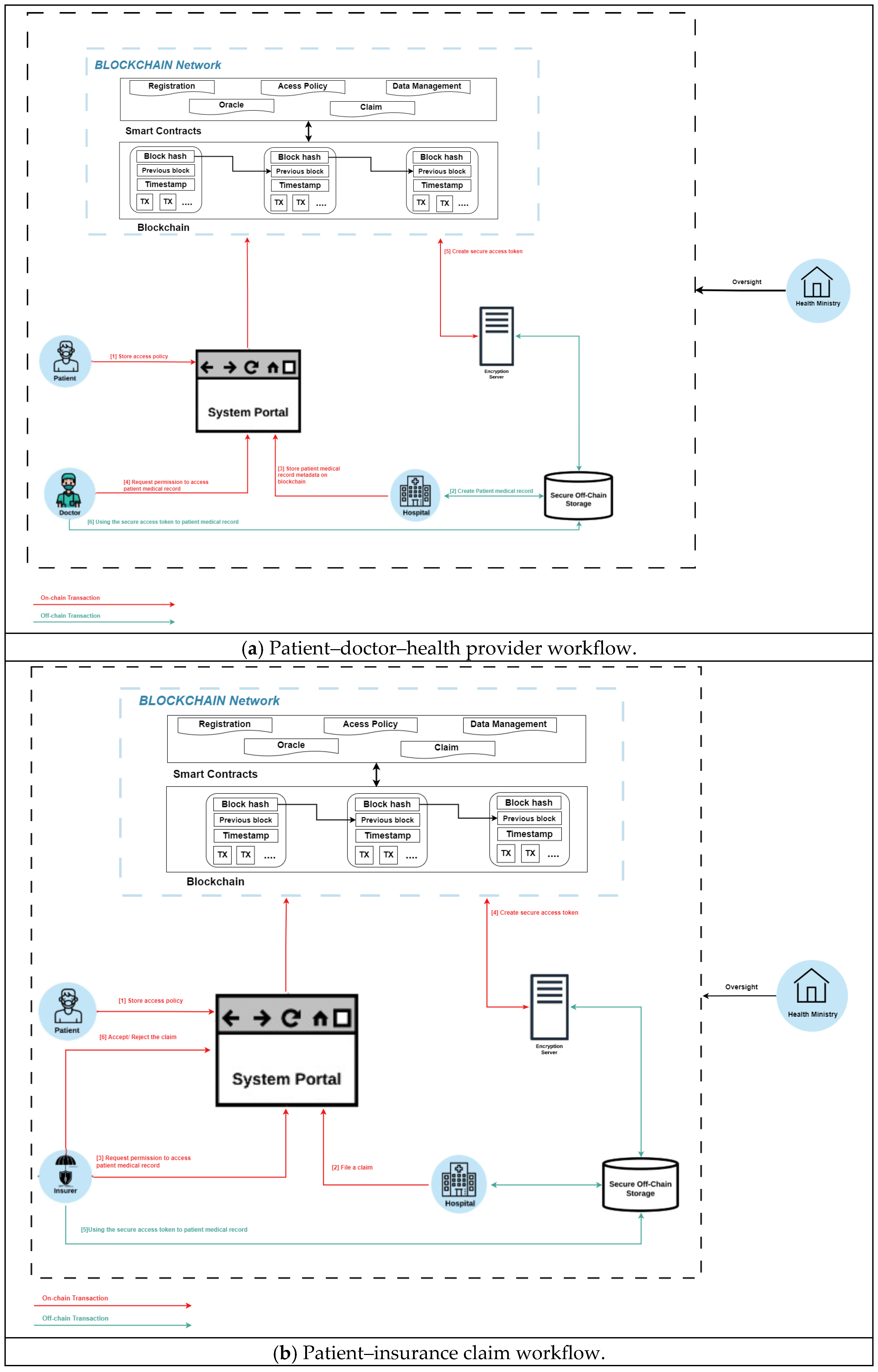

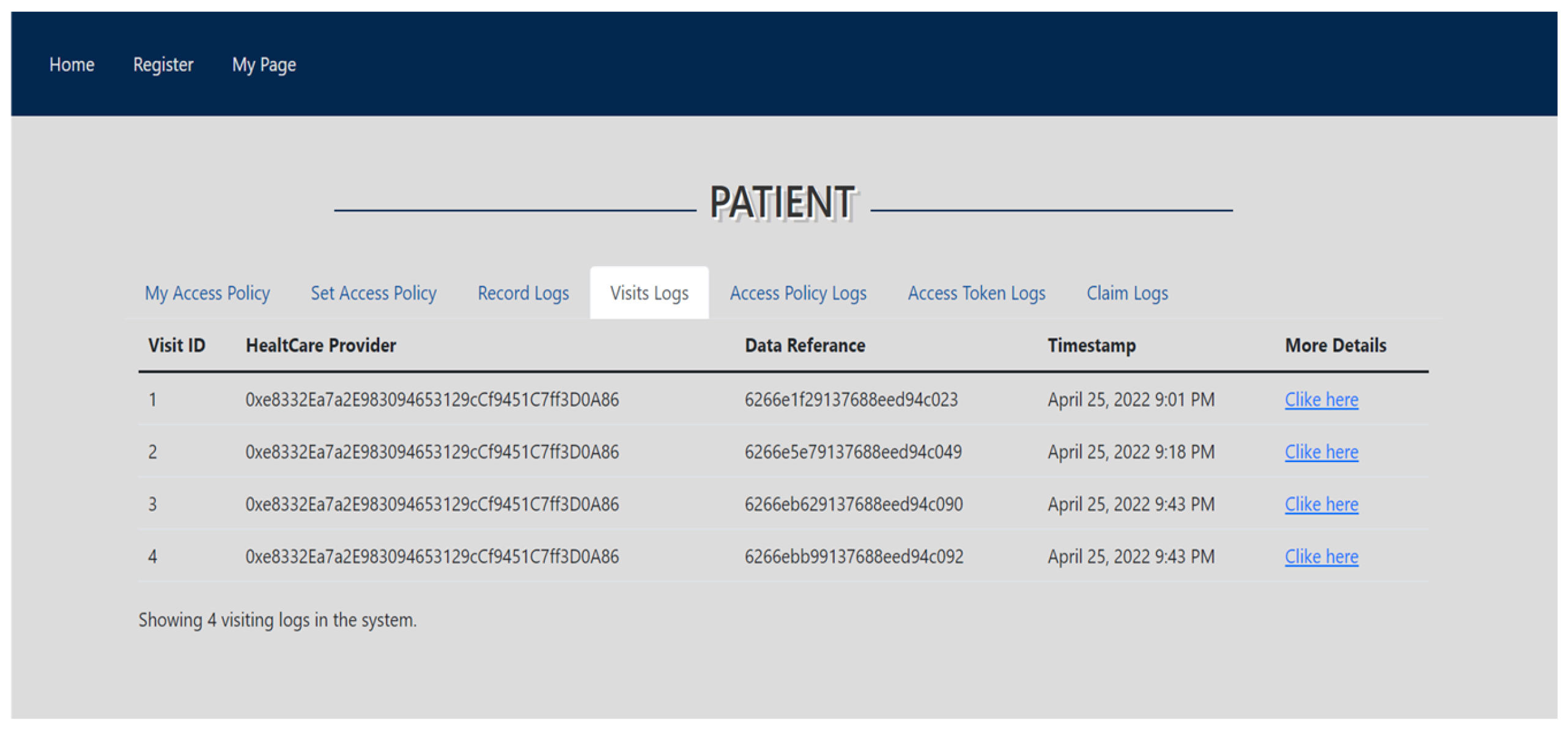
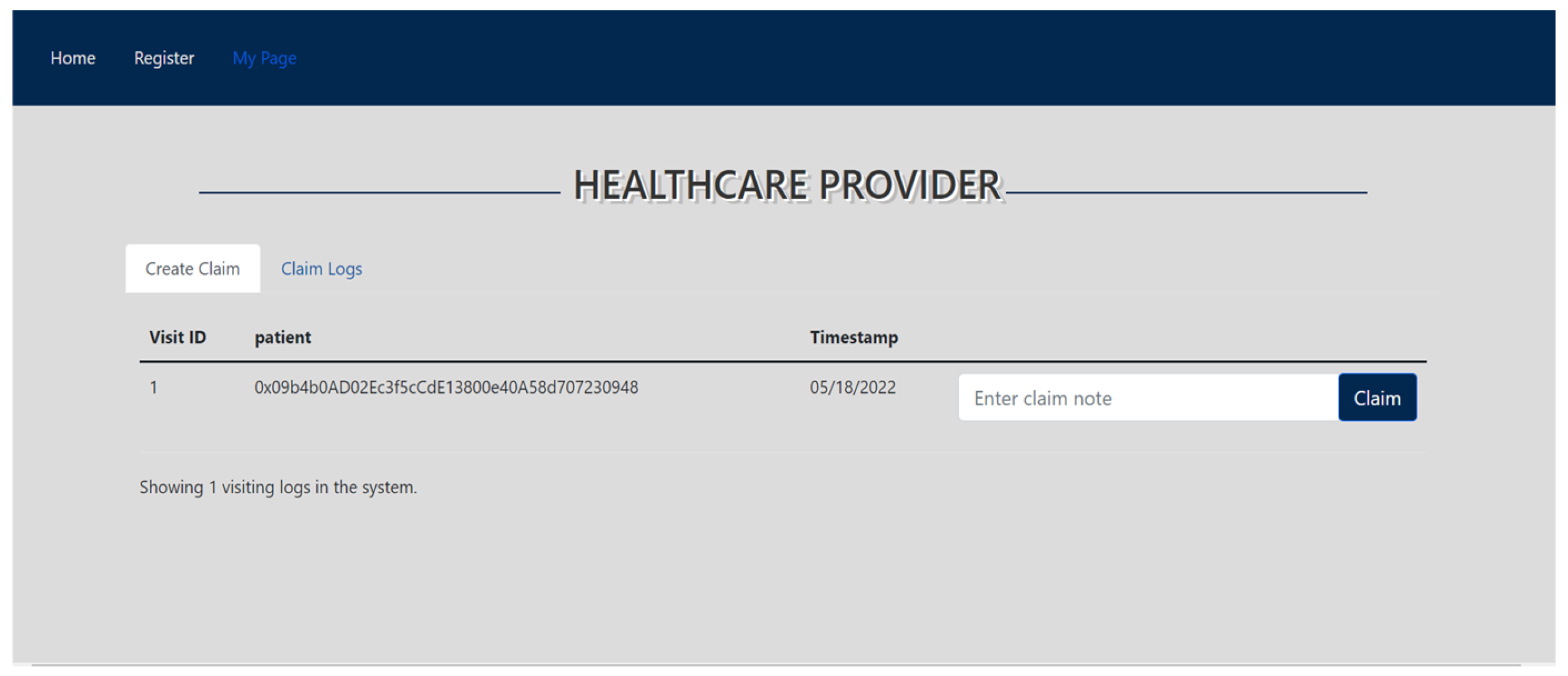

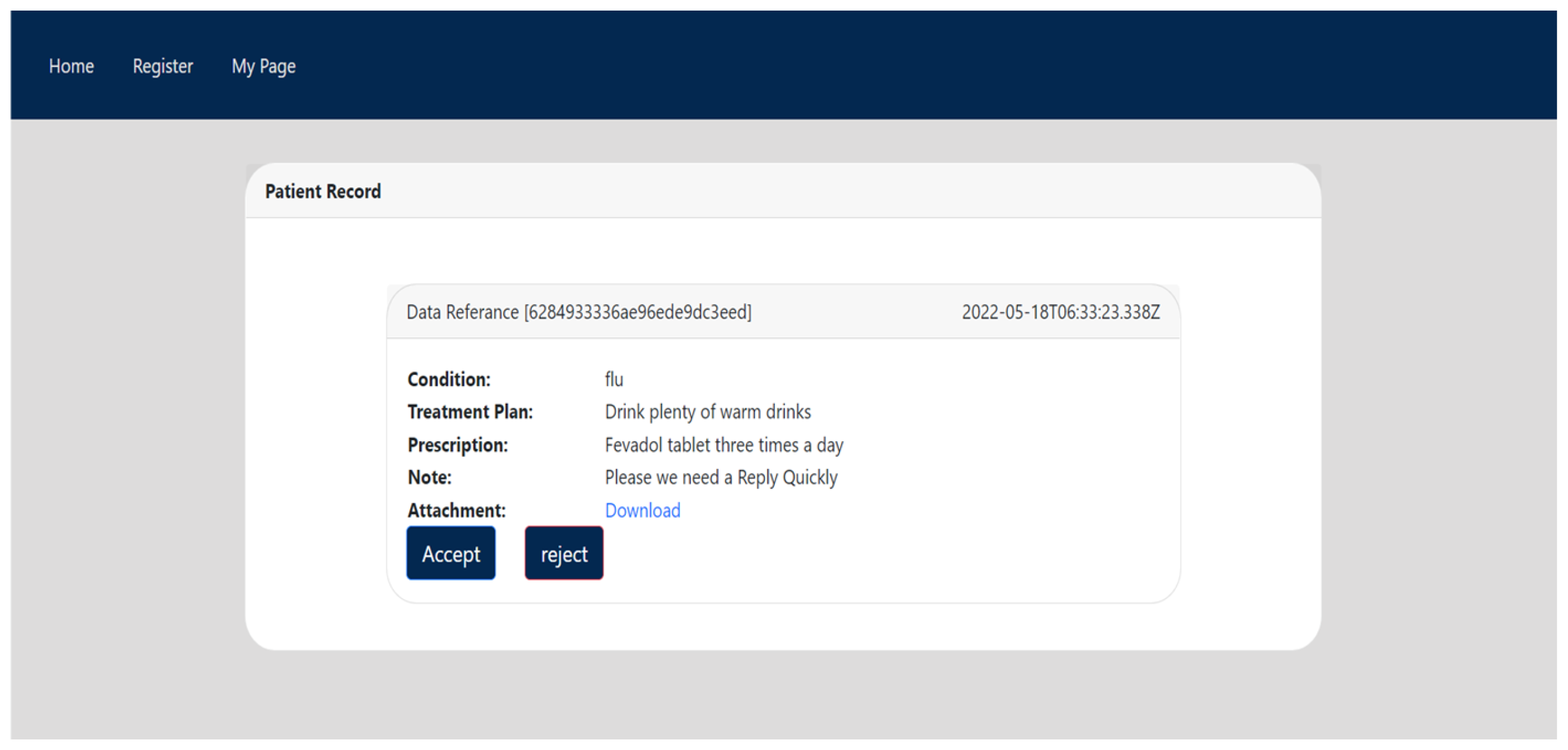
| System | Privacy and Security | Data Fragmentation/Interoperability | Collaboration Among Stakeholders | Limitation Compared to Proposed System |
|---|---|---|---|---|
| BlockTrial [27] | Protects patient data integrity in clinical trials | Not designed for cross-provider records | Focuses on patients, researchers, and regulators only | Does not support general medical record sharing across hospitals, insurers, and regulators |
| Ancile [33] | Strong privacy-preserving access control | Provides interoperable EHR exchange | Limited to patients and healthcare providers | Lacks support for insurance companies and regulators in the cooperation model |
| MediBchain [25] | Pseudonymity protects patient identity | Records restricted to registered parties only | Covers patients and healthcare providers | Does not address insurer/regulator cooperation; limited interoperability |
| BBDS [34] | Uses encryption and digital signatures | Enables secure cloud-based sharing | Focuses mainly on patients and cloud providers | Does not provide multi-stakeholder cooperation in the healthcare ecosystem |
| Tahir et al. [35] | Employs smart contracts, blockchain, and IPFS for privacy and integrity | Enhances interoperability through IPFS integration | Covers mainly patients and providers | Does not address insurer/regulator cooperation; lacks full multi-stakeholder workflows |
| HealthRec-Chain [36] | Uses IPFS with GPG encryption and blockchain metadata for secure storage | Benchmarked for latency and throughput; supports scalable off-chain storage | Primarily patients and providers | Excludes insurers and regulators; cooperation scope limited |
| hChain 4.0 [37] | Combines AES, Partial Homomorphic Encryption, and ABAC for fine-grained access control | Designed for scalability in permissioned blockchain environments | Supports authorized users but not explicitly all stakeholders | Strong cryptographic model but lacks unified workflows covering patients, providers, insurers, and regulators |
| Parameter | Setting |
|---|---|
| Blockchain Platform | Ethereum (Ganache CLI local test network) |
| Consensus Mechanism | Proof of Authority (PoA, Ganache default) |
| Number of Nodes | 10 |
| Hardware Specification | Intel Core i7, 16 GB RAM, Windows 11 laptop |
| Development Tools | Remix IDE, Solidity 0.8.x, MetaMask |
| Operation | Latency (100 Users) | Throughput (300 Users) | ||
|---|---|---|---|---|
| Classic | Blockchain | Classic | Blockchain | |
| Patient views history (Read) | 28 ms | 46 ms | 582 req/s | 458 req/s |
| Doctor adds visit (Write) | 38 ms | 63 ms | 476 req/s | 348 req/s |
| Insurer processes claim (Mixed) | 42 ms | 67 ms | 441 req/s | 327 req/s |
Disclaimer/Publisher’s Note: The statements, opinions and data contained in all publications are solely those of the individual author(s) and contributor(s) and not of MDPI and/or the editor(s). MDPI and/or the editor(s) disclaim responsibility for any injury to people or property resulting from any ideas, methods, instructions or products referred to in the content. |
© 2025 by the authors. Licensee MDPI, Basel, Switzerland. This article is an open access article distributed under the terms and conditions of the Creative Commons Attribution (CC BY) license (https://creativecommons.org/licenses/by/4.0/).
Share and Cite
Alyahya, S.; Almaghrabi, Z. Blockchain-Based Cooperative Medical Records Management System. Computers 2025, 14, 447. https://doi.org/10.3390/computers14100447
Alyahya S, Almaghrabi Z. Blockchain-Based Cooperative Medical Records Management System. Computers. 2025; 14(10):447. https://doi.org/10.3390/computers14100447
Chicago/Turabian StyleAlyahya, Sultan, and Zahraa Almaghrabi. 2025. "Blockchain-Based Cooperative Medical Records Management System" Computers 14, no. 10: 447. https://doi.org/10.3390/computers14100447
APA StyleAlyahya, S., & Almaghrabi, Z. (2025). Blockchain-Based Cooperative Medical Records Management System. Computers, 14(10), 447. https://doi.org/10.3390/computers14100447







